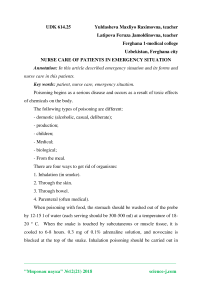Nurse care of patients in emergency situation
Автор: Yuldasheva Maxliyo Raximovna, Latipova Feruza Jamoldinovna
Журнал: Мировая наука @science-j
Рубрика: Основной раздел
Статья в выпуске: 12 (21), 2018 года.
Бесплатный доступ
In this article described emergency situation and its forms and nurse care in this patients.
Patient, nurse care, emergency situation
Короткий адрес: https://sciup.org/140263341
IDR: 140263341
Текст научной статьи Nurse care of patients in emergency situation
Poisoning begins as a serious disease and occurs as a result of toxic effects of chemicals on the body.
The following types of poisoning are different:
-
- domestic (alcoholic, casual, deliberate);
-
- production;
-
- children;
-
- Medical;
-
- biological;
-
- From the meal.
There are four ways to get rid of organisms:
-
1. Inhalation (in smoke).
-
2. Through the skin.
-
3. Through bowel.
-
4. Parenteral (often medical).
When poisoning with food, the stomach should be washed out of the probe by 12-15 l of water (each serving should be 300-500 ml) at a temperature of 1820 ° C. When the snake is touched by subcutaneous or muscle tissue, it is cooled to 6-8 hours. 0.3 mg of 0.1% adrenaline solution, and novocaine is blocked at the top of the snake. Inhalation poisoning should be carried out in fresh air and oxidized by respiratory tract. When skin is exposed to toxic substances, skin should be washed in running water.
When the toxic substance is injected into the rectum, the duca, and the urinary bladder, they should be split, sprinkled, and catheterized. Urinary tract is used to remove toxicity from the bloodstream. The main pathological syndromes in acute poisoning. Neurological changes vary widely, resulting from intoxication due to direct toxic effects on the structure of the central and peripheral nervous system, as well as due to infringement of the function of the other members of the poisoned (liver and kidney). The most severe psycho-clinical changes include intoxication psychosis, toxic coma, cramping syndrome. Disorders of cardiovascular activity are toxic shock, which can be accompanied by sudden drop in arterial pressure, swelling of the skin, tachycardia, chewing gum, and changes in blood structure. When poisoning the heart with primary toxic substances, heart rhythm, its permeability, and collapse develop.
Breathing disorder can be as follows:
-
1) aspiration-obturating form. It goes backwards because of the backwardness of the tongue and vomiting masses;
-
2) the central shape of breath change is the absence or shortage of volunteer breathing movements;
-
3) acute tracheobronxit with pulmonary edema, pneumonia, bronchospasm.
Gastrointestinal tract injury is associated with acute gastroenteritis, vomiting, diarrhea, pain in different parts of the abdomen and with different intensity. The liver's injury is an increase in the liver and pain the appearance of the sclera and the yellowing of the skin. The gastrointestinal tract may contain toxins, so the stomach and bowel should be washed.
Poisoning with sleeping substances.
The first aid is: The victim is in a coma or deep sleep. Breathing may occasionally be pale or cyanosis (bruising), increased temperature, and may eventually become rash. It is essential to use activated charcoal or some other sorbents, stomach ulcers, and strong intramuscular administration.
Alcohol intoxication.
It should not be forgotten that alcohol has a significant psychotropic effect when taken in large quantities. In the early stages, it can not be controlled, there is a decrease in pain and loss of consciousness. The first aid is to quickly digest the stomach, provide respiratory tract permeability, give heart medications and, if possible, begin oxygen therapy.
Gas poisoning.
Gas is generated when the vehicle is exhausted and the houses are heated with stoves. Acute poisoning has psycho-neurological disorders, including headache, dizziness, thirst, vomiting, dizziness, and respiratory distress. The first aid begins with the immediate withdrawal of the victim from the oven. It is necessary to provide bronchial permeability, prolonged administration of airoxygen mixture and cardio-vascular preparation.
Poisoning with flammable substances.
This is the essence of acetic (vinegar). Clinical course is caused by local fires and general-resorption. Patients complained of severe pain in the throat, vomiting, and delay in breathing. Loss of fluid causes shock. Erythrocyte decay sign - red or brown urine. Treatment is based on the treatment of gastric lavage, promedol, and heart medication. Bleeding in gastric lavage is a directive that does not interfere with washing (no alkaline solution is forbidden).
Excitations arise when there are obstacles to air passage to the lungs. It can be based on falling, injuries or susceptible spasms of longitudinal bodies on upper respiratory tract. When first aid in breathing is done first, it is necessary to try to create favorable conditions for fresh air, and then start resuscitation.
Acute allergic reactions. All medicines (antibiotics, serums and vaccines) and certain fruit products are allergic to: eggs, chocolate, honey, strawberries, citrus fruits. The weight of the allergic reaction is determined by the degree of sensitization.
Anaphylactic shock is a serious allergic reactions package. Permanent symptoms of anaphylactic shock include acute arteriosclerosis, sharp drop in blood pressure, swelling of the face or hyperemia, cyanosis, severe sweating, pulse incision. The frequency and accuracy of the heart rhythm is disturbed. Lung cancer may develop, and breathing may develop, sputum absorption in large quantities, acne in the lungs, and bronchospasm. Psychomotor irregularities may occur, which can lead to loss of consciousness, inevitably leads to urinary separation and defecation. Occasionally, separate muscle groups and tonic or clonic movements may occur.
Список литературы Nurse care of patients in emergency situation
- Барыкина Н.В., Зарянская В.Г. Сестринское дело в хирургии. - Ростов-на-Дону: «Феникс», 2010.
- Yunusjonova Z.S., Mirzayeva S.A., Bositxonova E.I. Psixologik parvarish. «O‘zbekiston faylasuflari milliy jamiyati», - T., 2010.
- Hamrayev A.J., Xamedova M.A. Xirurgiya. - T.: «O‘qituvchi», 2009.
- Ziyayeva M.F. xirurgik kasalliklar bilan og‘rigan va intensiv terapiyani o‘tayotgan bemorlarda hamshiralik parvarishi. -T., Niso poligraf, 2017.


